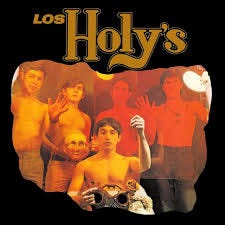House of the Holy's: When Kids in Peru Held a Funhouse Mirror Up to Rock and Roll
An unexpected counterpoint to the tyranny of classic rock
We like it when the echoes come back in different form. When the musical elements that activate the nostalgia cortex – like, say, the eternal melody of “Unchained Melody” – get spun around and twisted just enough to suggest some distant exotic otherness. When the known is transformed on the fly, with splashes of local color or a well-timed unhinged yowl of manic abandon.
These are the echoes that can catch the attention of the perpetually jaded. They offer (alas momentary) relief from the tyranny of the pop and classic rock shortlist, those original hits by the original artists that provide a neutral (some would argue mind-numbing) background for any and every public setting. Did your errand day really need another trip through “Fly Like an Eagle”? Too bad! You’re destined for one. Good luck escaping.
That’s Los Holy’s version of “Unchained Melody.” It belongs to a moment in global pop culture, the middle-to-late 1960s, when rock and roll was moving like a contagion – spreading its instantly addictive beats and catchy refrains from the U.S. and the U.K. to the far reaches of Africa, Eastern Europe, Central and South America. Before it became inescapable, the default language of youth.
Peru fell hard. Bands that had been playing innocuous songbook tunes like “Autumn Leaves” jumped to the “Twist and Shout” side of the street. They started by treading lightly and playing things straight, doing studious covers of hits by the Ventures and others. Soon enough, these bands began stretching out the surf backbeats, chopping the rhythm guitar patterns into unconventional pixillations. Adding distorted, psychedelic droning from synthesizers and organs.
These musicians were quick studies; they made big, proudly garagey rock noises. They caught the wildcat energy that made records by the Rolling Stones, Cream and others so magnetic, and figured out how to harness it as a fuel source. They clearly loved the songs, but resisted the urge to mirror the small details of each; their versions of “Satisfaction” and other hits operate with a kind of outsider, almost punk irreverence.
Here's “Midnight Confessions,” one of the sunniest of the sunny hits by the Grass Roots, reimagined by The Fabulosos Belking’s.
And check out how, slightly later, the musicians of The Shain’s (also known as Los Nuevos Shains) interpreted Blind Faith’s “Sea of Joy.” It’s got the grace of the Steve Winwood-sung original, mixed with traces of the wistfulness that’s common to romantic boleros.
The original compositions these bands documented are even more interesting, building on and extending the bold irreverence of the covers. The title track of Los Holy’s classic album offers a series of epic guitar melodies, each draped in gorgeous spaghetti-western reverb; these are surrounded by chipper Farfisa organ stabs and defiantly odd pennywhistle swoops played on synthesizer.
This particular sonic swirl is, needless to say, original in the most fetching and curious ways. Even when these bands used more conventional foursquare rock tactics, they landed on sly, idiomatic subversions, like the masterfully measured pitch-bends of the Belking’s guitars here. It’s blues and not-blues at the same time.
Arguably the most interesting of the Lima based rock bands is Traffic Sound, a brainy, musically accomplished crew whose first album, A Bailar Go Go (1969), included covers of songs by the Doors, Cream, Jimi Hendrix, Iron Butterfly, the Animals and — more blues/not blues — Skip James. Evidently that was the band’s School of Rock moment, because the next effort – Virgin, released in 1970 – shows astonishing growth. There are no cover tunes this time, and within the originals are breathtaking compositional interludes (check the guitar-and-trumpet conversation on “Mashkalina,” link below) and unlikely fusions of rock rhythms with call-and-response vocals and traces of Andean folkloric music.
When I started down this extra-large rabbit hole, the first thought was that a bunch of this had to be AI generated. (It’s not!) Second thought was to create a playlist of covers, focusing on the inventive arrangements of these bands (and others, there were many!). Then I encountered the originals on Los Holy’s Sueno Sicodelico, and Traffic Sound’s Virgin, and realized, with a degree of amazement, that these bands developed at warp speed: One year they were trolling American Top Forty with cheeky celebrations of classic hits. And the very next year they’d left that all behind to explore startlingly original music – not exclusively “surf” or “garage rock,” just music that makes a delightful mess of the entire hair-splitting rock-subgenre classification system.
**
Speaking of AI, the drummers of these bands unwittingly provided us with an awesome AI-detection method: The drum fill. On much of the AI-generated music I’ve endured, the fills that link sections of songs together sound uniformly polished and intricate, planned carefully even when they’re not technically perfect. These drummers from Peru might have been capable of that, but on many of these recordings, they sound like they’re flailing away at full throttle, not thinking perfection just doing their best to maintain the flow of the music. The bots might execute with more precision, but give me the spastic careening human drum fill any day.





True! Gimme drums played by humans por favor....